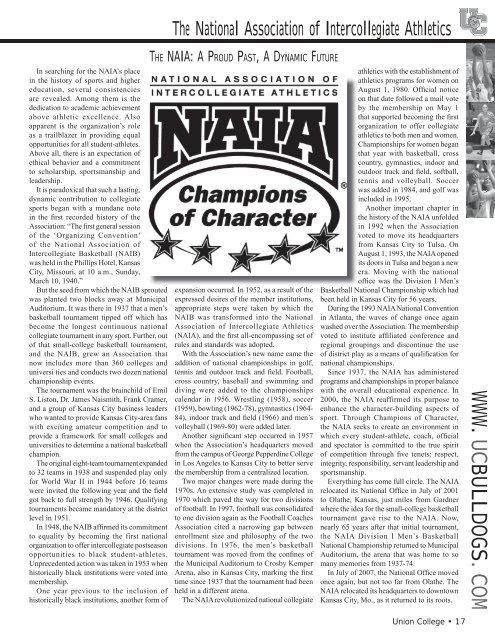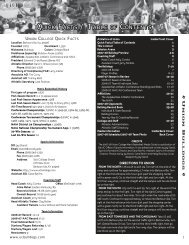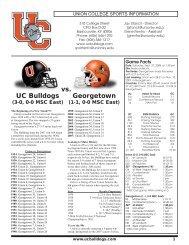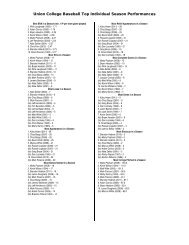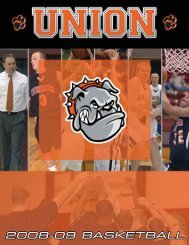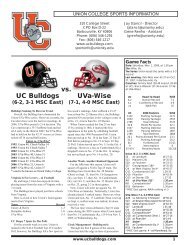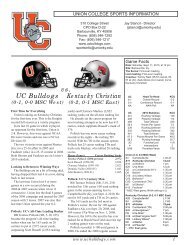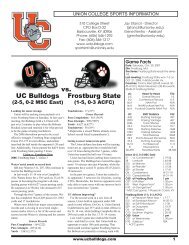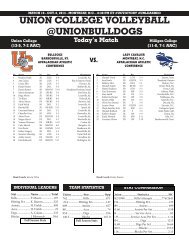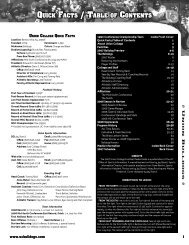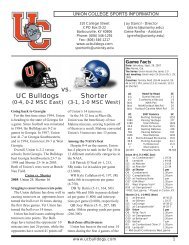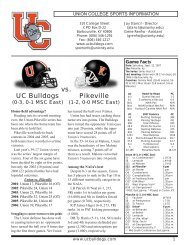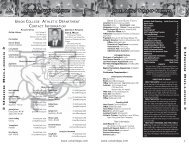WWW. UC BULLDOGS .COM
WWW. UC BULLDOGS .COM
WWW. UC BULLDOGS .COM
Create successful ePaper yourself
Turn your PDF publications into a flip-book with our unique Google optimized e-Paper software.
The National Association of Intercollegiate Athletics<br />
In searching for the NAIA’s place<br />
in the history of sports and higher<br />
education, several consistencies<br />
are revealed. Among them is the<br />
dedication to academic achievement<br />
above athletic excellence. Also<br />
apparent is the organization’s role<br />
as a trailblazer in providing equal<br />
opportunities for all student-athletes.<br />
Above all, there is an expectation of<br />
ethical behavior and a commitment<br />
to scholarship, sportsmanship and<br />
leadership.<br />
It is paradoxical that such a lasting,<br />
dynamic contribution to collegiate<br />
sports began with a mundane note<br />
in the first recorded history of the<br />
Association: “The first general session<br />
of the ‘Organizing Convention’<br />
of the National Association of<br />
Intercollegiate Basketball (NAIB)<br />
was held in the Phillips Hotel, Kansas<br />
City, Missouri, at 10 a.m., Sunday,<br />
March 10, 1940.”<br />
But the seed from which the NAIB sprouted<br />
was planted two blocks away at Municipal<br />
Auditorium. It was there in 1937 that a men’s<br />
basketball tournament tipped off which has<br />
become the longest continuous national<br />
collegiate tournament in any sport. Further, out<br />
of that small-college basketball tournament,<br />
and the NAIB, grew an Association that<br />
now includes more than 360 colleges and<br />
universi ties and conducts two dozen national<br />
championship events.<br />
The tournament was the brainchild of Emil<br />
S. Liston, Dr. James Naismith, Frank Cramer,<br />
and a group of Kansas City business leaders<br />
who wanted to provide Kansas City-area fans<br />
with exciting amateur competition and to<br />
provide a framework for small colleges and<br />
universities to determine a national basketball<br />
champion.<br />
The original eight-team tournament expanded<br />
to 32 teams in 1938 and suspended play only<br />
for World War II in 1944 before 16 teams<br />
were invited the following year and the field<br />
got back to full strength by 1946. Qualifying<br />
tournaments became mandatory at the district<br />
level in 1951.<br />
In 1948, the NAIB affirmed its commitment<br />
to equality by becoming the first national<br />
organization to offer intercollegiate postseason<br />
opportunities to black student-athletes.<br />
Unprecedented action was taken in 1953 when<br />
historically black institutions were voted into<br />
membership.<br />
One year previous to the inclusion of<br />
historically black institutions, another form of<br />
THE NAIA: A PROUD PAST, A DYNAMIC FUTURE<br />
expansion occurred. In 1952, as a result of the<br />
expressed desires of the member institutions,<br />
appropriate steps were taken by which the<br />
NAIB was transformed into the National<br />
Association of Intercollegiate Athletics<br />
(NAIA), and the first all-encompassing set of<br />
rules and standards was adopted.<br />
With the Association’s new name came the<br />
addition of national championships in golf,<br />
tennis and outdoor track and field. Football,<br />
cross country, baseball and swimming and<br />
diving were added to the championships<br />
calendar in 1956. Wrestling (1958), soccer<br />
(1959), bowling (1962-78), gymnastics (1964-<br />
84), indoor track and field (1966) and men’s<br />
volleyball (1969-80) were added later.<br />
Another significant step occurred in 1957<br />
when the Association’s headquarters moved<br />
from the campus of George Pepperdine College<br />
in Los Angeles to Kansas City to better serve<br />
the membership from a centralized location.<br />
Two major changes were made during the<br />
1970s. An extensive study was completed in<br />
1970 which paved the way for two divisions<br />
of football. In 1997, football was consolidated<br />
to one division again as the Football Coaches<br />
Association cited a narrowing gap between<br />
enrollment size and philosophy of the two<br />
divisions. In 1976, the men’s basketball<br />
tournament was moved from the confines of<br />
the Municipal Auditorium to Crosby Kemper<br />
Arena, also in Kansas City, marking the first<br />
time since 1937 that the tournament had been<br />
held in a different arena.<br />
The NAIA revolutionized national collegiate<br />
athletics with the establishment of<br />
athletics programs for women on<br />
August 1, 1980. Official notice<br />
on that date followed a mail vote<br />
by the membership on May 1<br />
that supported becoming the first<br />
organization to offer collegiate<br />
athletics to both men and women.<br />
Championships for women began<br />
that year with basketball, cross<br />
country, gymnastics, indoor and<br />
outdoor track and field, softball,<br />
tennis and volleyball. Soccer<br />
was added in 1984, and golf was<br />
included in 1995.<br />
Another important chapter in<br />
the history of the NAIA unfolded<br />
in 1992 when the Association<br />
voted to move its headquarters<br />
from Kansas City to Tulsa. On<br />
August 1, 1993, the NAIA opened<br />
its doors in Tulsa and began a new<br />
era. Moving with the national<br />
office was the Division I Men’s<br />
Basketball National Championship which had<br />
been held in Kansas City for 56 years.<br />
During the 1993 NAIA National Convention<br />
in Atlanta, the waves of change once again<br />
washed over the Association. The membership<br />
voted to institute affiliated conference and<br />
regional groupings and discontinue the use<br />
of district play as a means of qualification for<br />
national championships.<br />
Since 1937, the NAIA has administered<br />
programs and championships in proper balance<br />
with the overall educational experience. In<br />
2000, the NAIA reaffirmed its purpose to<br />
enhance the character-building aspects of<br />
sport. Through Champions of Character,<br />
the NAIA seeks to create an environment in<br />
which every student-athlete, coach, official<br />
and spectator is committed to the true spirit<br />
of competition through five tenets: respect,<br />
integrity, responsibility, servant leadership and<br />
sportsmanship.<br />
Everything has come full circle. The NAIA<br />
relocated its National Office in July of 2001<br />
to Olathe, Kansas, just miles from Gardner<br />
where the idea for the small-college basketball<br />
tournament gave rise to the NAIA. Now,<br />
nearly 65 years after that initial tournament,<br />
the NAIA Division I Men’s Basketball<br />
National Championship returned to Municipal<br />
Auditorium, the arena that was home to so<br />
many memories from 1937-74.<br />
In July of 2007, the National Office moved<br />
once again, but not too far from Olathe. The<br />
NAIA relocated its headquarters to downtown<br />
Kansas City, Mo., as it returned to its roots.<br />
<strong>WWW</strong>.<strong>UC</strong><strong>BULLDOGS</strong>.<strong>COM</strong><br />
Union College • 17


